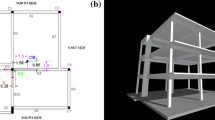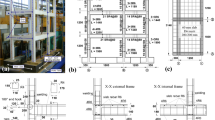Abstract
A ground motion with a PGA of 0.39 g, above the 475-year design earthquake specified in the Greek seismic code and the National Annex to Eurocode 8, was recorded about 100 m from the municipal theatre of Argostoli, the capital of the Ionian island of Kefalonia. The building, the largest in volume in the town, was designed and constructed to the 1959 seismic code for lateral loads (about 30 % of those specified today). Suffering also from severe reinforcement corrosion and poor concrete quality, it provided the ground to apply for the first time (in 2005) Part 3 of Eurocode 8 for seismic assessment and retrofitting. The assessment based on nonlinear dynamic analysis showed that the buidling was deficient even under ground motions with PGA less than 0.05 g. Alongside the need to tackle corrosion, the design of the retrofitting had to face several constraints and requirements: minimal disruption of the facility’s operation, accessibility to the foundation only along the building perimeter, no change to the façade and minimal intervention to the other lateral sides. A very cost-effective retrofitting was designed, employing: (a) one-sided RC or fibre-reinforced polymer (FRP) overlays and two new walls at the perimeter, (b) connection of the two structurally independent and torsionally imbalanced units of the building in a single structure, and (c) one-sided FRP jacketing of selected interior elements. Less than 7 years after the works were completed, the building went unscathed through a Magnitude 6.1 earthquake. Serious damage was limited to four nonstructural masonry infill panels at the penthouse, which, according to the retrofit design, could be sacrificed, so as to protect vulnerable structural elements that could not be retrofitted in the first place. Nonlinear dynamic analyses of the response of the retrofitted building to the recorded ground motions are in agreement with the observed performance. They show also that, had the as-built facility not been retrofitted, it might have collapsed in the earthquake.

















Similar content being viewed by others
References
AUTH-ITSAK-OASP (1996) Influence of local soil conditions, geomorphology and dynamic soil-foundation-structure interaction on the records of the national strong motion network. Final report. Aristotle University & Institute of Engineering Seismology and Earthquake Resistant Structures. Thessaloniki (in Greek)
Biskinis DE, Fardis MN (2010a) Deformations at flexural yielding of members with continuous or lap-spliced bars. Struct Concr 11(3):127–138
Biskinis DE, Fardis MN (2010b) Flexure-controlled ultimate deformations of members with continuous or lap-spliced bars. Struct Concr 11(2):93–108
Biskinis DE, Roupakias G, Fardis MN (2004) Degradation of shear strength of RC members with inelastic cyclic displacements. ACI Struct J 101(6):773–783
CEN (2004) European Standard EN 1998-1:2004 Eurocode 8: Design of structures for earthquake resistance—part 1: General, seismic actions, rules for buildings. Comite Europeen de Normalisation, Brussels
CEN (2005) European Standard EN 1998-3:2005 Eurocode 8: Design of structures for earthquake resistance—Part 3: Assessment and retrofitting of buildings. Comite Europeen de Normalisation, Brussels
Kosmopoulos A, Bousias SN, Fardis MN (2007) Seismic rehabilitation of a theater facility according to Eurocode 8 using CFRPs. In: 8th International Symposium on Fiber Reinforced Polymer Reinforcement for Concrete Structures (FRPRCS-8), Patras
Otani S (1974) Inelastic analysis of R/C frame structures. ASCE J Struct Div 100(ST7):1433–1449
Papazachos BC (1996) Large seismic faults in the Hellenic arc. Annali di Geofisica 39(5):891–903
Papazachos BC, Papazachou C (1997) The earthquakes of Greece. Ziti Publishings, Thessaloniki
Scordilis EM, Karakaisis GF, Karakostas BG, Panagiotopoulos DG, Comninakis PE, Papazachos BC (1985) Evidence for transform faulting in the Ionian sea: the Cephalonia island earthquake sequence of 1983. Pure Appl Geophys 123:388–397
SHARE project (http://www.share-eu.org/)
Theodoulidis N, Margaris B, Papaioannou C et al (2014) The Kefalonia earthquake (M: 6.1) of January 26, 2014: Preliminary report. Institute of Engineering Seismology and Earthquake Resistant Structures (ITSAK), Thessaloniki (in Greek)
Acknowledgments
The Municipality of Argostoli in Kefalonia supported the seismic assessment and design of the retrofitting via a contract with the University of Patras, and implemented the intervention. P. Delakas, engineer in the Engineering Service of the Municipality, played a very important role in alerting the Municipality to the reinforcement corrosion, supporting the option of retrofitting per Part 3 of Eurocode 8 instead of demolition, and following it up till the end of the implementation. The study of the effects of the 26-01-2014 earthquake has received funding from the Hellenic General Secretariat for Research and Technology under Grant ERC-12 (PRESCIENT) of the Operational Program “Education and lifelong learning”, co-funded by the European Union (European Social Fund) and national resources.
Author information
Authors and Affiliations
Corresponding author
Rights and permissions
About this article
Cite this article
Fardis, M.N., Liosatou, E. & Kosmopoulos, A.J. Analysis of first building retrofitted to EN-Eurocode 8 versus performance under near-design-level earthquake. Bull Earthquake Eng 13, 2567–2590 (2015). https://doi.org/10.1007/s10518-015-9740-3
Received:
Accepted:
Published:
Issue Date:
DOI: https://doi.org/10.1007/s10518-015-9740-3




